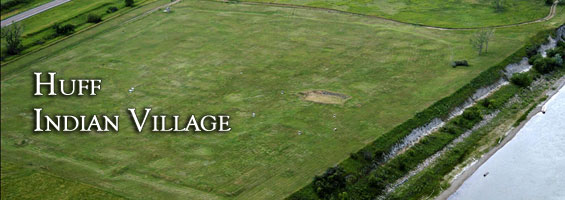We’ve launched a new web portal! Visit findhistory.nd.gov to search our collections.
Due to a road closure, the Killdeer Mountain Battlefield State Historic Site is temporarily closed.

Huff Indian Village State Historic Site is a classic prehistoric Mandan settlement dating to about AD 1450, perhaps two hundred years before Euroamerican influence reached the Missouri Valley area. The village is a very large, well-planned community where perhaps a thousand or more people once lived. Huff Village was probably occupied only for a short time (perhaps 20 years), as indicated by the clarity of the village plan and lack of evidence for rebuilding and trash accumulation.
The site is in pristine condition, and the community layout is easily seen on the surface. Depressions marking the locations of more than one hundred lodges are arranged roughly in rows, paralleling the river bank. The entire settlement is surrounded by a massive fortification system consisting of a ditch more than two thousand feet long with ten well-defined bastions. The village, including its fortifications, covers about twelve acres.
The residents of the village practiced a combination of farming and intensive bison hunting resulting in a diversified and flexible economy. Farming produced a large surplus of food (dried corn, beans, and squash) which could be stored for use and traded to nomadic, non-farming groups.
Residents of Huff Village were clearly concerned about conflicts with other Indian peoples in the region, most likely attacks from other village farmers, probably ancestors of historic Arikara Indians, who moved from the Central Plains into South Dakota during the AD 1400s. Today, the Fort Berthold Reservation in northwest North Dakota is home to the Mandans, along with the Hidatsas and Arikaras.
Address:
Located one-half mile south of Huff, ND.
Get Directions
Hours:
Open year round.
Contact Us:
phone: 701.328.2666
email: history@nd.gov